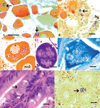Microsporidiosis in zebrafish research facilities
- PMID: 23382342
- PMCID: PMC4117576
- DOI: 10.1093/ilar.53.2.106
Microsporidiosis in zebrafish research facilities
Abstract
Pseudoloma neurophilia (Microsporidia) is the most common pathogen detected in zebrafish (Danio rerio) from research facilities. The parasite infects the central nervous system and muscle and may be associated with emaciation and skeletal deformities. However, many fish exhibit subclinical infections. Another microsporidium, Pleistophora hyphessobryconis, has recently been detected in a few zebrafish facilities. Here, we review the methods for diagnosis and detection, modes of transmission, and approaches used to control microsporidia in zebrafish, focusing on P. neurophilia. The parasite can be readily transmitted by feeding spores or infected tissues, and we show that cohabitation with infected fish is also an effective means of transmission. Spores are released from live fish in various manners, including through the urine, feces, and sex products during spawning. Indeed, P. neurophilia infects both the eggs and ovarian tissues, where we found concentrations ranging from 12,000 to 88,000 spores per ovary. Hence, various lines of evidence support the conclusion that maternal transmission is a route of infection: spores are numerous in ovaries and developing follicles in infected females, spores are present in spawned eggs and water from spawning tanks based on polymerase chain reaction tests, and larvae are very susceptible to the infection. Furthermore, egg surface disinfectants presently used in zebrafish laboratories are ineffective against microsporidian spores. At this time, the most effective method for prevention of these parasites is avoidance.
Figures


References
-
- Baker DG. Natural Pathogens of Laboratory Animals: Their Effects on Research. Washington: ASM Press; 2003.
-
- de Kinkelin P. Occurrence of a microsporidian infection in zebra Danio, Brachydanio rerio (Hamilton-Buchanan) J Fish Dis. 1980;3:71–73.
-
- Docker MF, Devlin RH, Richard J, Khattra J, Kent ML. Sensitive and specific polymerase chain reaction assay for detection of Loma salmonae (Microsporea) Dis Aquat Org. 1997;29:41–48.
-
- Dyková I. Phylum Microspora. In: Woo PTK, editor. Fish Diseases and Disorders. Volume 1: Protozoan and Metazoan Infections. Cambridge MA: CABI; 1995. pp. 149–179.
-
- Ferguson JA, Watral V, Schwindt AR, Kent ML. Spores of two fish microsporidia (Pseudoloma neurophilia and Glugea anomala) are highly resistant to chlorine. Dis Aquat Org. 2007;76:205. - PubMed
Publication types
MeSH terms
Grants and funding
LinkOut - more resources
Full Text Sources

